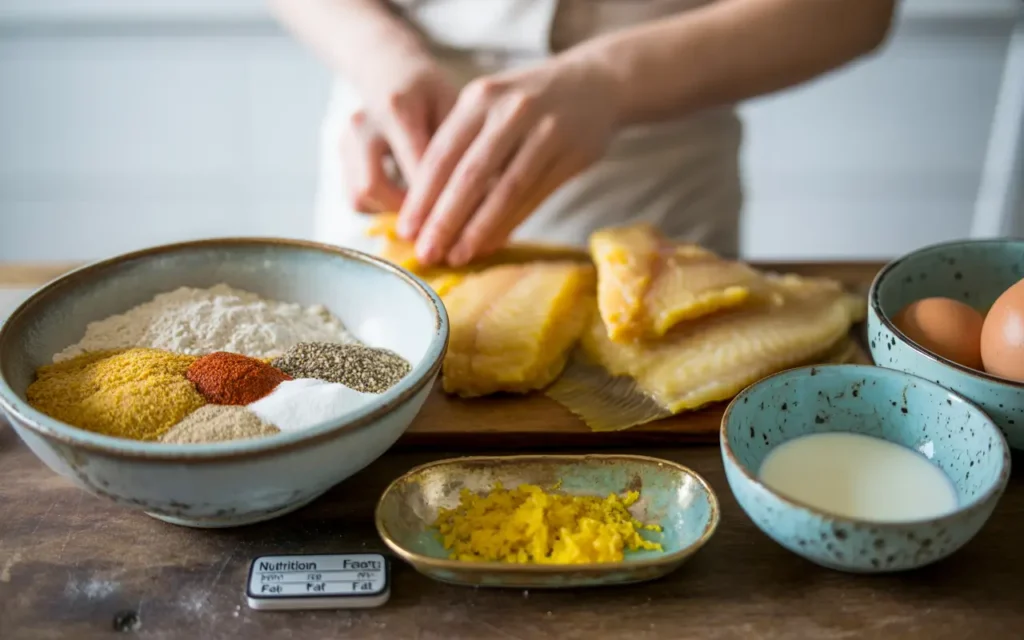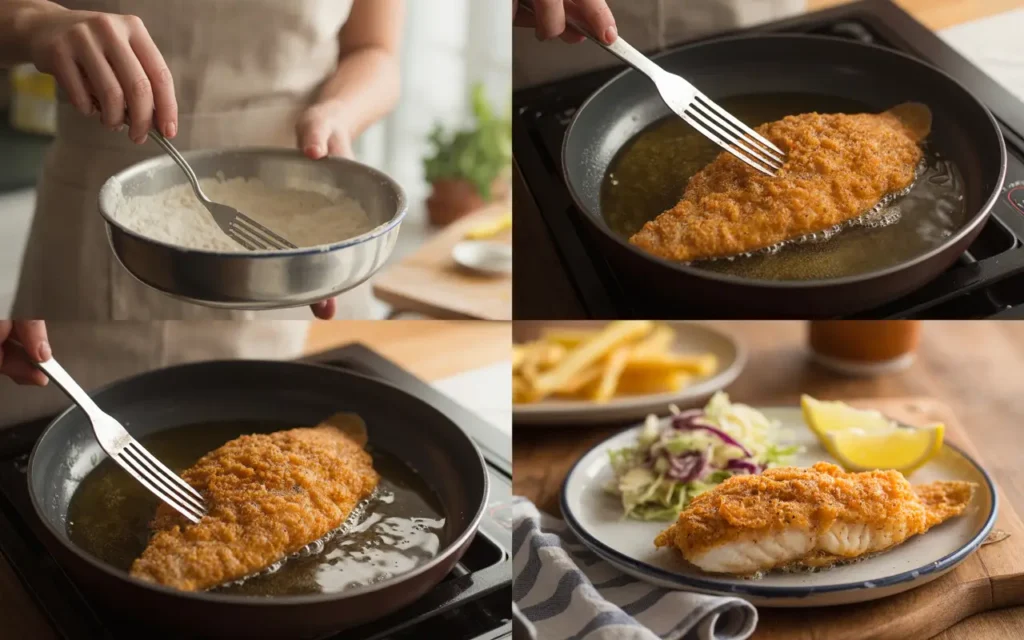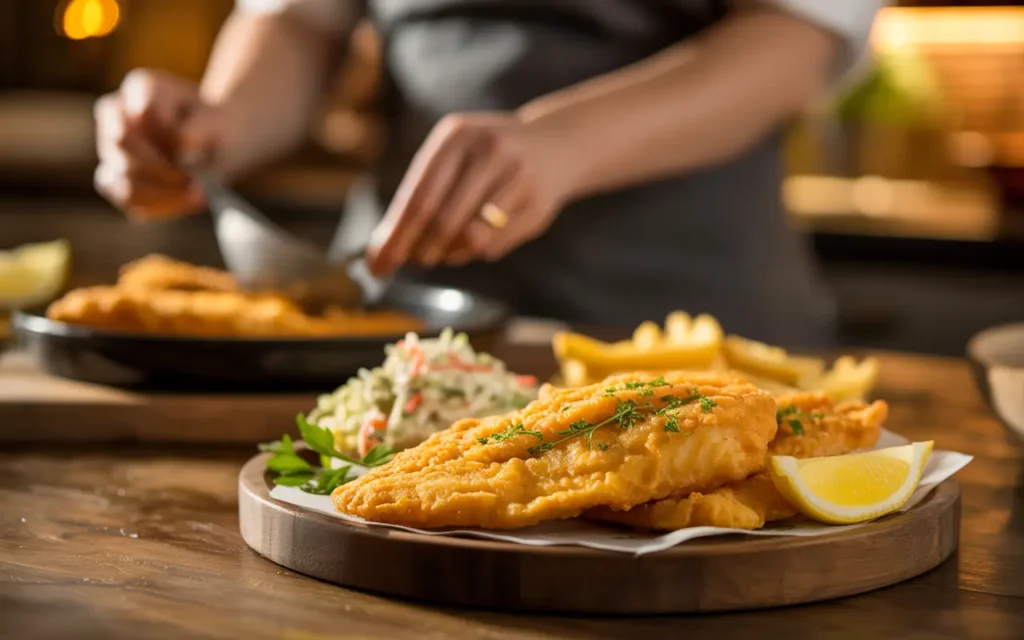Introduction
Growing up on the Carolina coast, flounder was a staple in our family meals. I can still picture my dad coming home with his catch of the day, that proud smile as he’d announce, “Flounder for dinner tonight!” My love for fried flounder fish recipes began in that small kitchen, watching my mom dredge those delicate fillets in seasoned cornmeal before they hit the sizzling pan.
Have you ever struggled to get that perfect golden crust on your fried fish without it falling apart? Trust me, I’ve been there! Let me tell you a secret, I tried frying flounder at least seven different ways before landing on this foolproof method that delivers crispy, flavorful results every single time.
Table of Contents
Ingredients List

For the Classic Southern Fried Flounder:
- 4 fresh flounder fillets (about 1½ pounds total)
- 1 cup all-purpose flour
- 1 cup yellow cornmeal (I get mine from a local mill near my house – the texture makes all the difference!)
- 2 teaspoons salt
- 1 teaspoon freshly ground black pepper
- 1 teaspoon paprika
- ½ teaspoon garlic powder
- ½ teaspoon onion powder
- ¼ teaspoon cayenne pepper (adjust to your heat preference)
- 2 large eggs
- ⅓ cup buttermilk (no buttermilk? I often substitute with milk plus 1 teaspoon of lemon juice)
- Vegetable oil for frying
- Lemon wedges for serving
When you open a fresh flounder fillet, you’ll notice that delicate sweet aroma that’s unique to this fish – it’s subtle but distinctive, a sign of its freshness. I first discovered this amazing seafood market just outside of Charleston where the owner, Mike, taught me how to select the freshest flounder by looking for clear, bright eyes and firm flesh.
For the Panko-Crusted Herb Flounder:
- 4 flounder fillets (about 1½ pounds)
- 1 cup panko breadcrumbs
- ¼ cup finely chopped fresh parsley
- 2 tablespoons finely chopped fresh dill
- 2 teaspoons lemon zest (I use a microplane that my sister gave me last Christmas)
- ½ teaspoon garlic powder
- ½ teaspoon salt
- ¼ teaspoon black pepper
- 2 eggs, beaten
- ½ cup all-purpose flour
- Olive oil cooking spray
- 2 tablespoons olive oil
Timing
Classic Southern Fried Flounder:
- Preparation time: 15 minutes
- Cooking time: 10-12 minutes
- Total time: 25-27 minutes
I typically prep the seasoned flour mixture on Sunday evenings and store it in an airtight container, which makes this dish perfect for those hectic Wednesday nights when the kids have soccer practice and homework is piling up.
Panko-Crusted Herb Flounder:
- Preparation time: 20 minutes
- Cooking time: 8-10 minutes
- Total time: 28-30 minutes
This version takes a few extra minutes to chop the fresh herbs, but I promise it’s worth every second. It’s my go-to when I have guests coming over but still need to keep dinner preparation under 30 minutes.
Step-by-Step Instructions

Classic Southern Fried Flounder
Step 1: Prepare the Fish
Rinse the flounder fillets under cold water and pat them completely dry with paper towels. This step is crucial – the first time I made this recipe, I skipped proper drying and the coating slid right off in the pan! Season both sides of each fillet with a pinch of salt.
Step 2: Set Up Your Dredging Station
In a shallow dish, whisk together flour, cornmeal, salt, pepper, paprika, garlic powder, onion powder, and cayenne. In another dish, beat eggs and buttermilk until well combined.
I learned the hard way to keep one hand for wet ingredients and one for dry – otherwise, you’ll end up with what my kids now hilariously call “mummy fingers” with layers of gummy coating!
Step 3: Heat the Oil
Pour vegetable oil into a large, heavy skillet to a depth of about ¼ inch. Heat over medium-high heat until the oil reaches approximately 350°F. If you don’t have a thermometer (I didn’t for years!), drop a small pinch of cornmeal into the oil – it should sizzle immediately but not burn.
Step 4: Dredge the Fillets
Take each fillet and first dip it in the egg mixture, allowing excess to drip off. Then thoroughly coat in the cornmeal mixture, pressing gently to adhere. Shake off any excess coating.
Step 5: Fry to Perfection
Carefully place the coated fillets in the hot oil, working in batches if necessary to avoid overcrowding (a mistake I made when rushing once, and ended up with soggy fish instead of crispy). Fry for 3-4 minutes on each side until golden brown and the fish flakes easily with a fork.
Trust me on this – resist the urge to flip them too early! Let that beautiful crust develop before turning.
Step 6: Drain and Serve
Transfer the fried fillets to a plate lined with paper towels to absorb excess oil. Serve immediately with lemon wedges for squeezing over the top.
Panko-Crusted Herb Flounder
Step 1: Prepare the Coating Mixtures
In a shallow dish, combine panko breadcrumbs, chopped parsley, dill, lemon zest, garlic powder, salt, and pepper. Place the beaten eggs in a second dish and the flour in a third dish.
The first version of this recipe didn’t include herbs, but after my trip to the farmers market last spring, I came home with fresh dill and parsley that completely transformed this dish.
Step 2: Preheat the Oven
Preheat your oven to 375°F. Line a baking sheet with parchment paper and spray lightly with olive oil cooking spray.
Step 3: Coat the Fish
Working with one fillet at a time, dredge in flour, then dip in beaten eggs, and finally coat thoroughly with the panko-herb mixture, pressing gently to adhere.
Step 4: Pan-Sear and Bake
Heat olive oil in a large oven-safe skillet over medium-high heat. Place the coated fillets in the hot skillet and cook for 2 minutes on each side until golden but not fully cooked through.
Step 5: Finish in the Oven
Transfer the skillet to the preheated oven and bake for 5-6 minutes until the fish is cooked through and flakes easily with a fork.
I discovered this pan-sear-then-bake method by accident when my stovetop was acting up, and now it’s my favorite way to ensure the coating stays crispy while the fish remains tender and moist.
Nutritional Information
Classic Southern Fried Flounder (per serving):
- Calories: 320
- Protein: 28g
- Carbohydrates: 25g
- Fat: 12g
- Fiber: 1g
- Sodium: 680mg
Panko-Crusted Herb Flounder (per serving):
- Calories: 295
- Protein: 27g
- Carbohydrates: 22g
- Fat: 10g
- Fiber: 1g
- Sodium: 520mg
As a blogger who cares deeply about balanced nutrition, I always try to pair protein-rich fish with a side of veggies. Both of these recipes offer lean protein with moderate carbohydrates. The herbs in the panko version add extra nutrients and flavor without extra calories – a win-win in my kitchen!
Healthier Alternatives for the Recipe
Looking to make these fried flounder fish recipes even healthier? I’ve got you covered with some tried-and-true modifications:
- Air Fryer Version: After my daughter was diagnosed with high cholesterol last year, I experimented with using the air fryer. Spray the coated fillets with olive oil cooking spray and air fry at 380°F for 10-12 minutes, flipping halfway through. You’ll get that same satisfying crunch with significantly less oil.
- Gluten-Free Option: When my nephew was visiting with his celiac diagnosis, I substituted regular flour with almond flour and used gluten-free panko. The result was surprisingly delicious – even my husband couldn’t tell the difference!
- Lower Carb Alternative: Replace half or all of the breadcrumbs with crushed pork rinds or almond flour. This modification reduces carbs while maintaining that essential crispiness.
- Baked-Only Method: Skip the frying altogether and bake the coated fillets at 425°F for 12-15 minutes. While not exactly the same texture as fried, this method cuts down on calories and mess – perfect for busy weeknights when I’m helping with homework while cooking dinner.
Serving Suggestions

These crispy fried flounder fish recipes deserve equally delicious accompaniments! Here are my family’s favorite pairings:
For Classic Southern Fried Flounder:
- Homemade coleslaw (my grandmother’s recipe with a tangy apple cider vinegar dressing)
- Corn on the cob brushed with herb butter
- Southern-style green beans with bacon (I omit the bacon when my vegetarian sister visits)
- Hush puppies (these were the surprising star of my son’s 10th birthday dinner!)
For Panko-Crusted Herb Flounder:
- Roasted asparagus with lemon (this combination was a hit at our last neighborhood potluck)
- Garlic mashed potatoes
- Mixed green salad with homemade buttermilk ranch dressing
- Quinoa pilaf with diced bell peppers (a recent addition that my previously quinoa-resistant husband now requests)
For a complete meal that balances flavors and textures, I love serving either version with a bright, acidic element like a squeeze of fresh lemon or a tangy remoulade sauce. This cuts through the richness of the fried coating and enhances the delicate flavor of the flounder.
Common Mistakes to Avoid
After years of frying flounder (including some memorable disasters!), here are the pitfalls you’ll want to avoid:
- Wet Fish: Not thoroughly patting the fillets dry before coating. The first time I cooked this for my in-laws, I was in such a rush that I skipped this step. The coating slid right off in the pan – talk about a kitchen nightmare with company waiting!
- Oil Temperature: Using oil that’s not hot enough or too hot. When I first started frying fish, I’d get impatient and add the fillets before the oil was ready. The result? Soggy, oil-absorbed coating instead of that satisfying crunch.
- Overcrowding the Pan: Adding too many fillets at once. During last year’s Fourth of July gathering, I tried to cook eight fillets simultaneously. Big mistake! The temperature dropped dramatically, and the fish steamed instead of fried.
- Thin Coating: Not pressing the coating firmly onto the fish. My daughter once helped by sprinkling the coating “like fairy dust” – sweet but not effective for creating that perfect crust!
- Premature Flipping: Turning the fish too early. Trust me, patience pays off here. Let that crust form completely before flipping, or you’ll end up with half the coating stuck to the pan instead of your fish.
Storing Tips for the Recipe
While these fried flounder fish recipes are best enjoyed fresh and hot, life happens, and sometimes you need to save leftovers or prep ahead:
Leftovers Storage: Store any leftover fried flounder in an airtight container in the refrigerator for up to 2 days. I discovered through trial and error that placing a paper towel in the container helps absorb moisture and prevents the coating from becoming soggy.
Reheating Method: For the crispiest results when reheating, place the fillets on a wire rack over a baking sheet in a 350°F oven for 10-12 minutes. Avoid the microwave at all costs – a lesson I learned when my son decided to “help” by microwaving leftover fish for lunch. The smell lingered for days!
Make-Ahead Tips: On busy weeks, I often prepare the coating mixtures on Sunday and store them in labeled containers. The herb-panko mixture stays fresh in the refrigerator for up to 3 days, making weeknight dinner prep a breeze when I’m rushing home from my daughter’s dance recitals.
Freezing Option: While not ideal, you can freeze the uncooked, coated fillets by placing them on a parchment-lined baking sheet until solid, then transferring to a freezer bag. Cook from frozen by adding 5-7 minutes to the cooking time. I keep these on hand for those “I forgot to plan dinner” emergencies that seem to happen at least once a month in our busy household!
FAQs
Can I use frozen flounder fillets?
Absolutely! I keep frozen flounder in my freezer for busy weeks. Just make sure to thaw them completely in the refrigerator overnight and pat them very dry before coating. Sarah from Texas recently asked me about this, and I recommended placing the thawed fillets on paper towels for 10 minutes before proceeding with the recipe.
What’s the best oil for frying flounder?
I prefer vegetable oil or canola oil because of their neutral flavors and high smoke points. After experimenting with olive oil once (it burned quickly and gave the fish a bitter taste), I’ve stuck with these reliable options. For a subtle flavor boost, you can also use peanut oil.
My coating keeps falling off during frying. What am I doing wrong?
This is probably the question I get most often! Make sure your fish is completely dry before coating, and after coating, let the fillets rest for about 5 minutes before frying. This waiting period (which I learned from my neighbor who used to be a restaurant chef) allows the coating to adhere better to the fish.
Can I make this recipe with other types of fish?
Definitely! While flounder has that perfect delicate texture for frying, I’ve successfully used this same method with tilapia, catfish, and even thin cod fillets. Each fish brings its own unique flavor, but the cooking technique remains the same.
How do I know when the fish is perfectly cooked?
Flounder cooks quickly! The fish is done when it’s opaque and flakes easily with a fork. For fillets that are about ½-inch thick, this usually takes 3-4 minutes per side. Overcooking is actually more common than undercooking – a mistake I made countless times until I started setting a timer.
Conclusion
These crispy fried flounder fish recipes transform a humble fillet into a meal that’s both comforting and impressive. Whether you choose the classic Southern-style with its perfectly seasoned cornmeal crust or the herb-infused panko version, you’re in for a delicious dinner that comes together in under 30 minutes.
I’m eager to hear about your experiences with these recipes! Share your photos with me on Instagram using the hashtag #BellaHarperRecipes or leave a comment below. Did you try any variations? Add a special side dish? I love seeing how you make these recipes your own in your kitchen!
If you enjoyed these fried flounder fish recipes, don’t forget to subscribe to my weekly newsletter for more family-friendly meals and cooking tips straight from my kitchen to yours. Happy cooking, friends!

